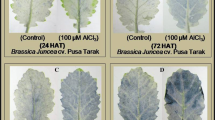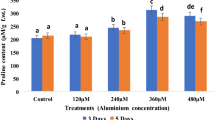Abstract
Aluminium-induced oxidative damage caused by excessive ROS production was evaluated in black gram pulse crop. Black gram plants were treated with different aluminium (Al3+) concentrations (10, 50 and 100 μM with pH 4.7) and further the effects of Al3+ were characterised by means of root growth inhibition, histochemical assay, ROS content analysis, protein carbonylation quantification and 1H-NMR analysis. The results showed that aluminium induces excessive ROS production which leads to cellular damage, root injury, stunt root growth and other metabolic shifts. In black gram, Al3+ induces cellular damage at the earliest stage of stress which was characterised from histochemical analysis. From this study, it was observed that prolonged stress can activate certain aluminium detoxification defence mechanism. Probably excessive ROS triggers such defence mechanism in black gram. Al3+ can induce excessive ROS initially in the root region then transported to other parts of the plant. As much as the Al3+ concentration increases, the rate of cellular injury and ROS production also increases. But after 72 h of stress, plants showed a lowered ROS level and cellular damage which indicates the upregulation of defensive mechanisms. Metabolic shift analysis also showed that the black gram plant under stress has less metabolic content after 24 h of treatment, but gradually, it was increased after 72 h of treatment. It was assumed that ROS played the most important role as a signalling molecule for aluminium stress in black gram.





Similar content being viewed by others
Abbreviations
- ROS:
-
Reactive oxygen species
- Al3+ :
-
Aluminium
- PC:
-
Protein carbonylation
- H2O2 :
-
Hydrogen peroxide
- FW:
-
Fresh weight
- DW:
-
Dry weight
References
Achary VM, Jena S, Panda KK, Panda BB (2008) Aluminium induced oxidative stress and DNA damage in root cells of Allium cepa L. Ecotoxicol Environ Saf 70(2):300–310
Aftab T, Khan MMA, Idress M, Naeem M, Moinuddin (2010) Effects of aluminum exposures on growth, photosynthetic efficiency, lipid peroxidation, antioxidation, antioxidant enzymes and artemisinin content of Artemisia annua L. J Phytol 2:23–37
Andrews F, Johan Bjorkten FB, Trenk AS, Koch RB (1965) The reaction of an auto oxidized lipids with proteins. J Am Oil Chem Soc 42:779–781
Boscolo PRS, Menossi M, Jorge R a (2003) Aluminum-induced oxidative stress in maize. Phytochemistry 62(2):181–189
Cançado GMA, Loguercio LL, Martins PR, Parentoni SN, Paiva E, Borém A, Lopes MA (1999) Hematoxylin staining as a phenotypic index for aluminum tolerance selection in tropical maize (Zea mays L.). TAG Theor Appl Genet 99(5):747–754
Carvalho MCS, van Raij B (1997) Calcium sulphate, phosphogypsum and calcium carbonate in the amelioration of acid subsoils for root growth. Plant Soil 192(1):37–48
Elstner EF (1982) Oxygen activation and oxygen toxicity. Annu Rev Plant Physiol 33(1):73–96
Elstner EF, Heupel A (1976) Formation of hydrogen peroxide by isolated cell walls from horseradish (Armoracia lapathifolia Gilib.). Planta 130(2):175–80
Elstner EF, Wagner GA, Schutz W (1988) Activated oxygen in green plants in relation to stress situations. Curr Top Plant Biochem Physiol 7:159–187
Foy CD (1988) Plant adaptation to acid, aluminium toxic soils. Commun Soil Sci Plant Anal 19:959–987
Hai TV, Nga TT, Laudelout H (1989) Effect of aluminium on the mineral nutrition of rice. Plant Soil 114(2):173–185
Hare PD, Cress WA (1997) Metabolic implications of stress-induced proline accumulation in plants. Plant Growth Regul 21:79–102
Hippeli S, Heiser I, Elstner EF (1999) Activated oxygen and free oxygen radicals in pathology: new insights and analogies between animals and plants. Plant Physiol Biochem 37(3):167–178
Ikegawa H, Yamamoto Y, Matsumoto H (1998) Cell death caused by a combination of aluminum and iron in cultured tobacco cells. Physiol Plant 104(3):474–478
Ikegawa H, Yamamoto Y, Matsumoto H (2000) Responses to aluminum of suspension-cultured tobacco cells in a simple calcium solution. Soil Sci Plant Nutr 46:503–514
Juszczuk IM, Tybura A, Rychter AM (2008) Protein oxidation in the leaves and roots of cucumber plants (Cucumis sativus L.), mutant MSC16 and wild type. J Plant Physiol 165(4):355–365
Kim C, Meskauskiene R, Apel K, Laloi C (2008) No single way to understand singlet oxygen signalling in plants. EMBO Rep 9(5):435–9
Kim HK, Choi YH, Verpoote R (2010) NMR based metabolomic analysis of plants. Nat Protoc 5:536–549
Kruger NJ, Troncoso-Ponce MA, Ratcliffe RG (2008) 1H NMR metabolite fingerprinting and metabolomic analysis of perchloric acid extracts from plant tissues. Nat Protoc 3(6):1001–12
Levine RL, Williams JA, Stadtman ER, Shacter E (1994) Carbonyl assays for determination of oxidatively modified proteins. Methods Enzymol 233:346–357
Meriga B, Krishna Reddy B, Rajender Rao K, Ananda Reddy L, Kavi Kishor PB (2003) Alleviating effect of citrate on aluminium toxicity of rice (Oryza sativa L.) seedling. Curr Sci 85(3):63–68
Meriga B, Krishna Reddy B, Rajender Rao K, Ananda Reddy L, Kavi Kishor PB (2004) Aluminium-induced production of oxygen radicals, lipid peroxidation and DNA damage in seedlings of rice (Oryza sativa). J Plant Physiol 161(1):63–68
Ohki K (1987) Aluminum stress on sorghum growth and nutrient relationships. Plant Soil 98(2):195–202
Ownby JD (1993) Mechanisms of reaction of hematoxylin with aluminium-treated wheat roots. Physiol Plant 87(3):371–380
Panda SK, Matsumoto H (2010) Changes in antioxidant gene expression and induction of oxidative stress in pea (Pisum sativum L.) under Al stress. BioMetals 23(4):753–762
Panda SK, Singha LB, Khan MH (2003) Does aluminium phytotoxicity induce oxidative stress in greengram (Vigna radiata)? Bulg J Plant Physiol 29(1–2):77–86
Panda SK, Baluska F, Matsumoto H (2009) Aluminum stress signaling in plants. Plant Signal Behav 4(7):592–7
Pollard A, Wyn Jones RG (1979) Enzyme activities in concentrated solutions of glycinebetaine and other solutes. Planta 144:291–298
Pompella A, Maellaro E, Casini AF, Comporti M (1987) Histochemical detection of lipid peroxidation in the liver of bromobenzene-poisoned mice. Am J Pathol 129(2):295–301
R Core Team (2013) A language and environment for statstical computing. R foundation for statstical computing, Vienna, Austria. URL http://www.R-project.org/
Ryan PR, Shaff JE, Kochian LV (1992) Aluminum toxicity in roots: correlation among ionic currents, ion fluxes, and root elongation in aluminum-sensitive and aluminum-tolerant wheat cultivars. Plant Physiol 99(3):1193–1200
Sagisaka S (1976) The occurrence of peroxide in a perennial plant Populas gelrica. Plant Physiol 57:308–309
Shao HB, Chu LY, Lu ZH, Kang CM (2008) Primary antioxidant free radical scavenging and redox signaling pathways in higher plant cells. Int J Biol Sci 4(1):8–14
Sharma M, Trofimova M, Sharma V, Tripathi BN (2015) Genotypic variation to aluminium sensitivity in chickpea depends on its ability to efficiently accumulate nitrate. Adv Agron Plant Sci 01(01):1–12
Singh D, Singh NP, Chauhan SK, Singh P (2011) Developing aluminium-tolerant crop plants using biotechnological tools. Curr Sci 100(12):1807–1814
Smirnoff N, Cumbes QJ (1989) Hydroxyl radical scavenging activity of compatible solutes. Phytochemistry 28:1057–1060
Song H, Xu X, Wang H, Wang H, Tao Y (2010) Exogenous gamma-aminobutyric acid alleviates oxidative damage caused by aluminium and proton stresses on barley seedlings. J Sci Food Agric 90(9):1410–6
Taylor GJ (1995) Overcoming barriers to understanding the cellular basis of aluminium resistance. Plant Soil 171(1):89–103
Van HL, Kuraishi S, Sakuraj N (1994) Aluminium-induced rapid root inhibition and changes in cell-wall components of squash seedlings. Plant Physiol 106:971–976
Von Uexküll HR, Mutert E (1995) Global extent, development and economic impact of acid soils. Plant Soil 171(1):1–15
Wang YS, Wang J, Yang ZM, Wang QY, Lu B, Li SQ, Lu YP, Wang SH, Sun X (2004) Salicylic acid modulates aluminum-induced oxidative stress in roots of Cassia tora. Acta Bot Sin-Eng Edn 46:819–828
Wang L, Fan X-W, Pan J-L, Huang Z-B, Li Y-Z (2015) Physiological characterization of maize tolerance to low dose of aluminum, highlighted by promoted leaf growth. Planta. doi:10.1007/s00425-015-2376-3
Wickham H (2009) ggplot2: Elegant graphics for data analysis. Springer-Verlag New York
Wu K, Xiao S, Chen Q, Wang Q, Zhang Y, Li K, Chen L (2012) Changes in the activity and transcription of antioxidant enzymes in response to Al stress in black soybeans. Plant Mol Biol Report 31(1):141–150
Yamamoto Y (2001) Lipid peroxidation is an early symptom triggered by aluminum, but not the primary cause of elongation inhibition in pea roots. Plant Physiol 125(1):199–208
Acknowledgments
We sincerely thank DBT, Govt. of India, for providing the facility for the research work. We thank IIPR, Kanpur, for providing black gram seeds for the present research work. We also sincerely thank DBT-Biotech Hub, Assam University, Silchar, for providing the facility for the research work.
Author information
Authors and Affiliations
Corresponding author
Ethics declarations
Conflict of interest
The authors declare that they have no competing interests.
Additional information
Handling Editor: Néstor Carrillo
Rights and permissions
About this article
Cite this article
Chowra, U., Yanase, E., Koyama, H. et al. Aluminium-induced excessive ROS causes cellular damage and metabolic shifts in black gram Vigna mungo (L.) Hepper. Protoplasma 254, 293–302 (2017). https://doi.org/10.1007/s00709-016-0943-5
Received:
Accepted:
Published:
Issue Date:
DOI: https://doi.org/10.1007/s00709-016-0943-5




